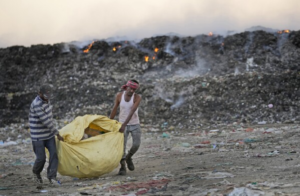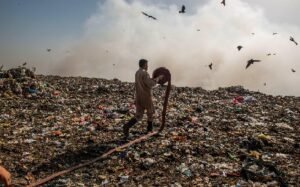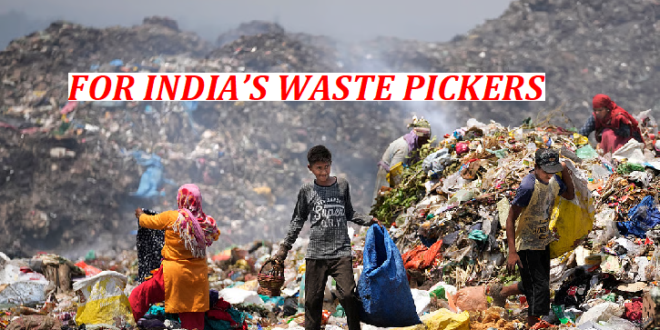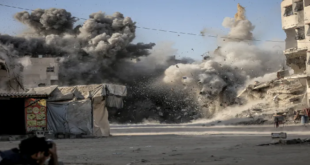18-08-2025
Bureau Report
NEW DELHI: “My right eye swells up in the heat, so I stopped going to the landfill last year,” says 38-year-old Sofia Begum, wiping her watering eyes. Begum married at the age of 13, and for more than 25 years, she and her husband have picked through mountains of rubbish at Delhi’s Ghazipur landfill, scavenging for recyclable waste they can sell to scrap dealers.
 Dressed in a ragged, green and yellow kurta, and sitting on a chair in a narrow lane in the middle of the slum settlement where she lives beside the dump site, Begum explains that she came into contact with medical waste in 2022, which infected her eye.
Dressed in a ragged, green and yellow kurta, and sitting on a chair in a narrow lane in the middle of the slum settlement where she lives beside the dump site, Begum explains that she came into contact with medical waste in 2022, which infected her eye.
Her eye swells up painfully when it is exposed to the sun for too long, so she has had to stop working in the summer months. Even in winter, she struggles to work as much as she used to.
“Now I can’t work as much. I used to carry 40 to 50 kilograms (88-110lbs) of waste a day. Now my capacity has reduced to half,” she says.
As temperatures in Delhi soared as high as 49 degrees Celsius (120 degrees Fahrenheit) in June, causing the India Meteorological Department (IMD) to issue an “orange alert” for two days, three rubbish sites at Ghazipur, Bhalswa and Okhla in India’s capital city became environmental ticking time bombs. Choking with rubbish and filled far beyond their capacity, these towering waste mountains have become hubs for toxic fires, methane leaks and an unbearable stench.
It’s a slow-burning public health threat that, every year, blights the lives of the tens of thousands of people who live in the shadow of these rubbish heaps.
Making a living from toxic work
Waste pickers are usually informal workers who earn a living by collecting, sorting and selling recyclable materials like plastic, paper and metal to scrap dealers. They are typically paid by those who buy the materials they forage, depending on the quality and quantity they can find and sort. As a result, they have no stable income and their work is hazardous, particularly in the summer months.
 According to a study published in the scientific journal Nature, the temperature at these landfill sites varies based on the size of the dump. The temperature from dumps exceeding 50 metres (164 feet) in height generally lies between 60 and 70C (158F) in the summer. This “heat-island effect” is caused by the decomposition of organic waste, which not only generates heat but also releases hazardous gases.
According to a study published in the scientific journal Nature, the temperature at these landfill sites varies based on the size of the dump. The temperature from dumps exceeding 50 metres (164 feet) in height generally lies between 60 and 70C (158F) in the summer. This “heat-island effect” is caused by the decomposition of organic waste, which not only generates heat but also releases hazardous gases.
“These landfills are gas chambers in the making,” says Anant Bhan, a public health researcher who has specialized in global health, health policy and bioethics for 20 years. “Waste pickers work in extreme heat, surrounded by toxic gases. This leads to long-term health complications,” he explains.
“Additionally, they are exposed to several gases, like the highly flammable methane, which causes irritation to their respiratory system. The rotting waste also leads to skin-related complications among the waste pickers.”
Ghazipur, which now towers at least 65 metres (213 ft) high equivalent to a 20-storey building has become a potent symbol of Delhi’s climate crisis.
Begum’s eye started swelling up in the intense heat last year. “I went to the doctor and he suggested surgery to treat my eye, which would cost me around 30,000 rupees ($350) but I don’t have that kind of money,” she says.
The Mohalla Clinics, an initiative started by former Chief Minister Arvind Kejriwal, offer free primary healthcare, medicines and diagnostic tests to residents in low-income areas.
 Pressmediaofindia
Pressmediaofindia




